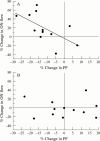Effect of isosorbide mononitrate on the human optic nerve and choroidal circulations
- PMID: 10396191
- PMCID: PMC1722947
- DOI: 10.1136/bjo.83.2.162
Effect of isosorbide mononitrate on the human optic nerve and choroidal circulations
Abstract
Aims: To assess the effects of the nitric oxide donor 5-isosorbide mononitrate (ISMO) on blood flow in the optic nerve head (ON flow) and choroid (Ch flow).
Methods: Laser Doppler flowmetry was used to measure ON flow and Ch flow in 12 normal subjects by aiming the laser beam at the fovea and at the temporal rim, respectively. In a double masked, randomised, crossover design, each subject received orally on separate days either 20 mg of 5-isosorbide mononitrate (ISMO) or placebo. Ch flow and ON flow were determined monocularly at baseline and 1 hour after dosing. In the last six subjects, additional measurements were obtained at 3 hours. Mean arterial blood pressure (BPm), heart rate, and intraocular pressure (IOP) were monitored, and ocular perfusion pressure (PP) was estimated.
Results: No significant changes in ON flow, PP, IOP, or BPm were observed following placebo. Following ISMO, ON flow increased from baseline by 19.8% (SEM 9.3%) at 1 hour (paired t test, p = 0.058) and by 33.1% (7.5%) at 3 hours (p = 0.007). Compared with the changes following placebo, statistically significant increases in ON flow were observed both at 1 (p = 0.050) and 3 hours (p = 0.041) after ISMO treatment. Compared with placebo, PP decreased significantly 1 hour after ISMO dosing (p = 0.039), mainly as a function of reduced BPm. A significant inverse correlation (R = -0.618; p = 0.032) was observed between the percentage changes in PP and ON flow 1 hour following ISMO administration, but not after placebo. No significant change in foveal Ch flow was documented.
Conclusions: These results suggest that, in normal subjects, ISMO increases significantly ON flow but not Ch flow. The inverse correlation observed between PP and ON flow suggests that the same mechanism(s) responsible for systemic vasodilatation and blood pressure decrease may also cause the ON flow increase.
Figures


References
Publication types
MeSH terms
Substances
Grants and funding
LinkOut - more resources
Full Text Sources
Other Literature Sources
Miscellaneous
